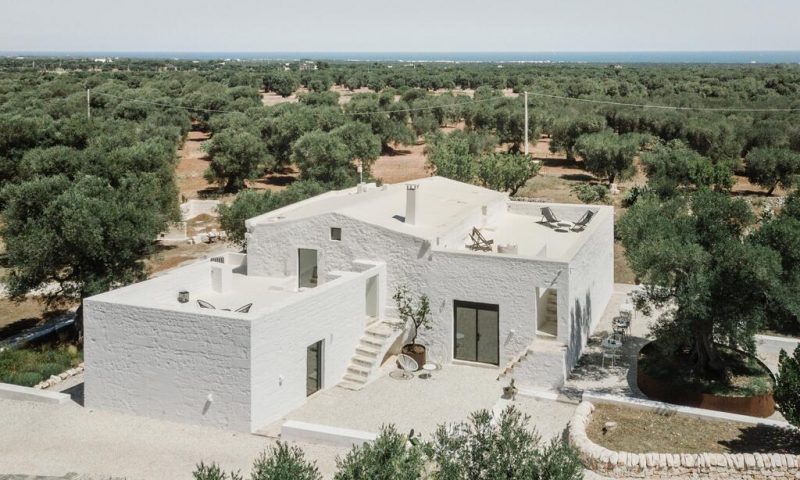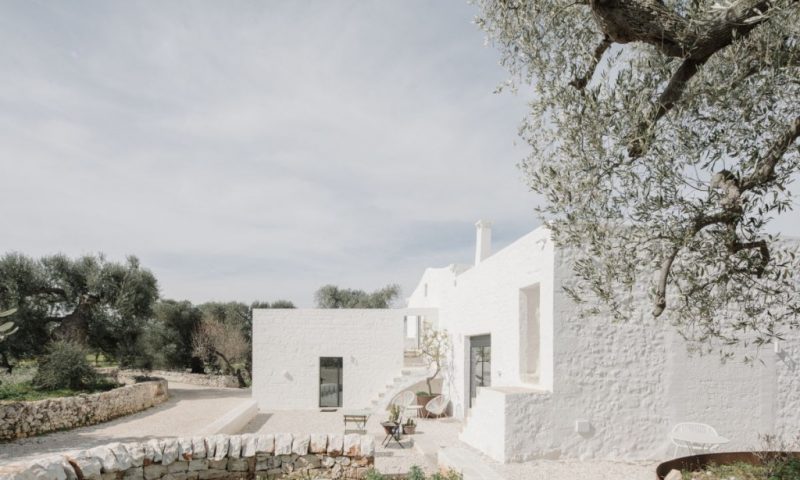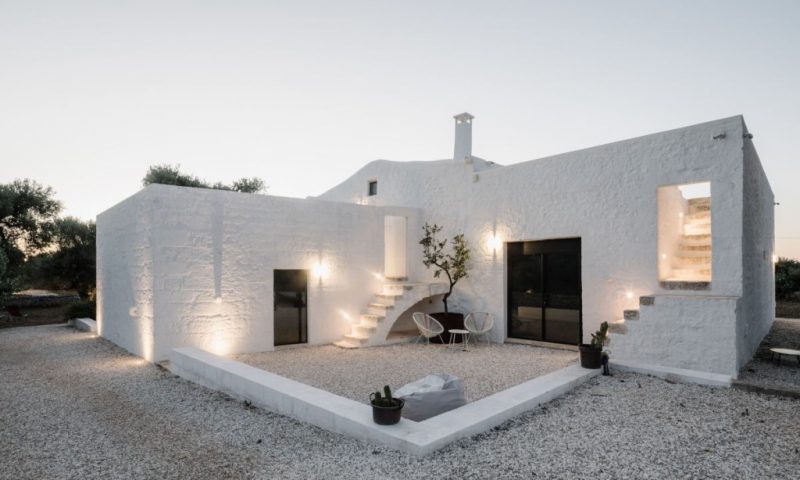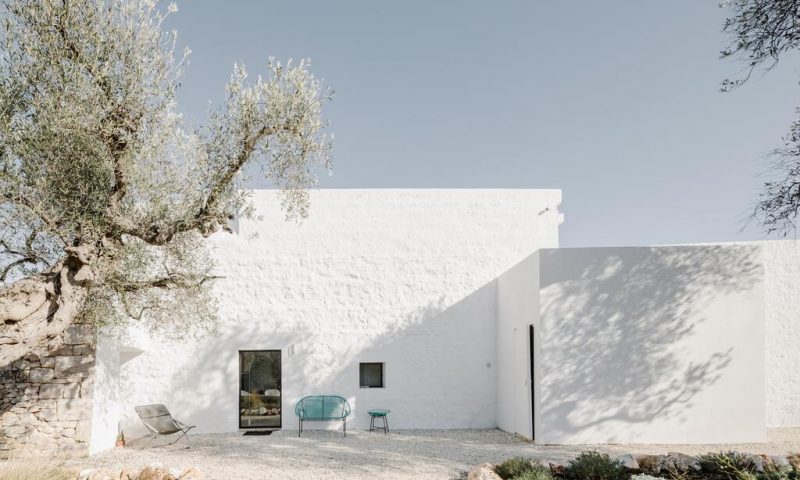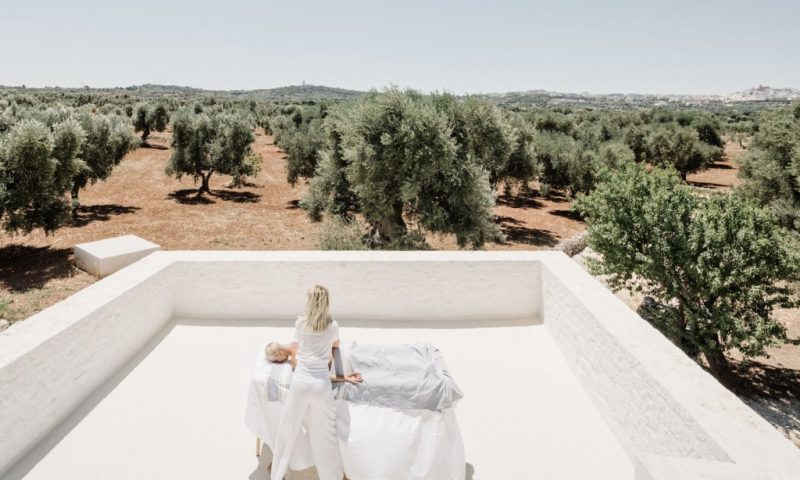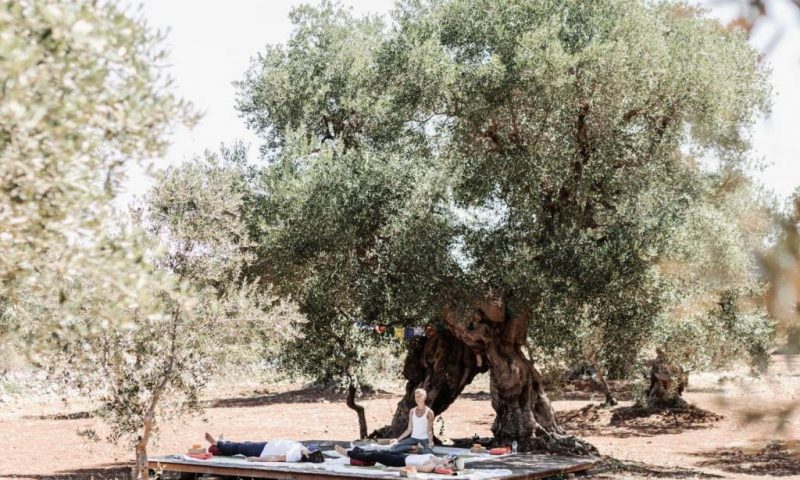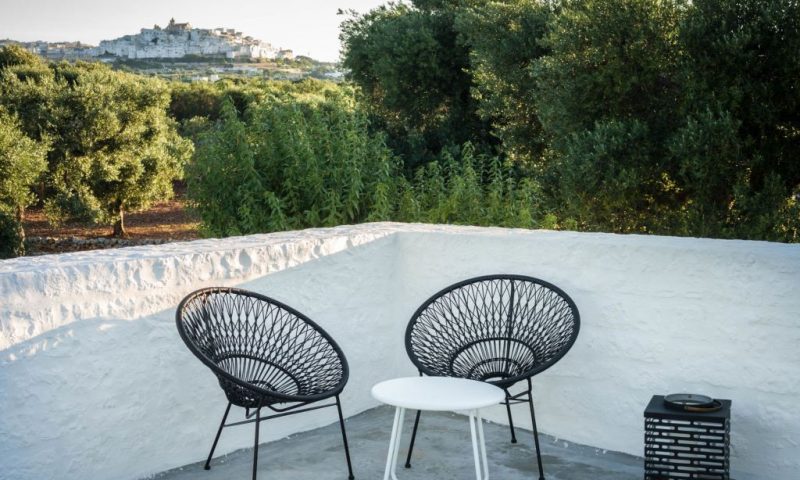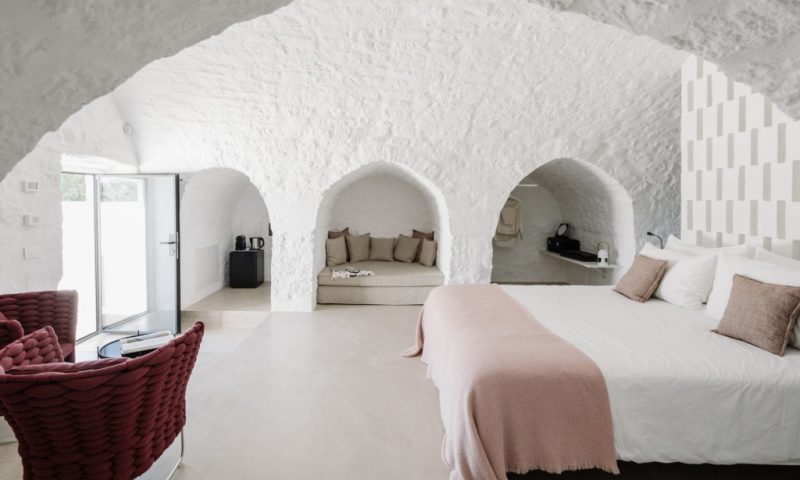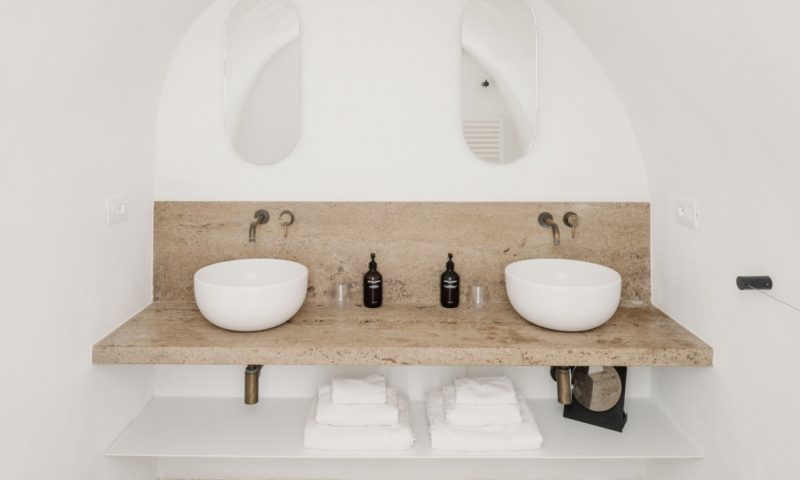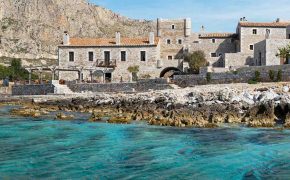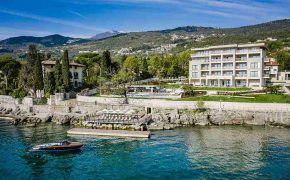Masseria Dagilupi is an old olive mill renovated as a charming guest house surrounded by millenary olive trees between Ostuni and the Adriatic Sea. With spacious rooms, large bathrooms, minimalist decoration at the best of Italian design, we want to offer another way to enjoy life in Puglia.
Our breakfasts are passionately prepared by ourselves with fresh local products. At the crossroads of Salento and Itria Valley, come and enjoy this hidden gem. Masserias are the soul of Puglia. For centuries, these imposing, often fortified constructions have experienced man’s hard work from dawn to dusk. Underlining the Apulian landscape, the Masserias emerge from the many olive groves.
Today, fully immersed in the Apulian countryside and surrounded by the scents and sounds of a unique terroir, these edifices are the ultimate places to relax. In 2018, after many years of diligent work in France, their natural passion for food and strong appeal for the region of Puglia led Danielle and Jean-Louis to plant their roots in this strip of Italian land.
THE OLD MILL
Masseria Dagilupi is a former oil mill surrounded by ancient olive trees, natural treasured monuments of this part of Puglia. The oldest part of Dagilupi dates back to 1600. Some discoveries in the mill during the renovation work are from the ‘ Magna Graecia ‘ era. History crosses this little gem nestled between the white houses of Ostuni to the West and the blue of the Adriatic Sea to the East.
THE RESTORATION
The restoration, respectful of the history of the place highlights the simple beauty of the Masseria. The refined decoration showcases the lime walls in the continuity between old and modern.
THE OLIVE GROVE
Only a 2-minute drive away from the beautiful town of Ostuni, also known as the White Pearl and surrounded by about 400 olive trees, one third of them millenary, Masseria Dagilupi is a place of charm and pure relaxation. Guests are invited to seat back, relax and enjoy the beauty of Puglia.
THE LOCATION
Between the Itria Valley and High Salento, Ostuni is the ideal starting point to explore the white towns of the inland and the ports of the Adriatic and Ionian coats. A little further away, Basilicata and Matera (European capital of culture 2019) offer an arider landscape and wide sandy beaches.
TERRACE SUITE OSTUNI
Located on the first floor of the Masseria this suite of 70sq. has a private terrace of 25sq. that offers an exceptional viewpoint of the expanse of secular olive trees and the foothills of Ostuni, white during the day, rose at sunset and shining of thousand fires at night.
This suite was once a living room and storage place where each niche allowed families to conserve their oil. The niches have been preserved to restore the typical atmosphere of an Apulian Masseria. The 20sq. bathroom with double shower, bathtub and double washbasin offers a view of the Adriatic Sea and the olive trees. 70sq. suite with de 25sq. private terrace
GARDEN SUITE
A secular olive tree offers its shade to the terrace of this suite of 50sqm in ground garden with direct access to the olive grove. In the past this piece communicated with the mill through a hatch through which the barely pressed oil was transported.
The stables were metamorphosed into a large open shower, a bathroom and a dressing room. The 1-meter thick stone walls protect this room from the summer sun’s ardors. Garden Suite of 50sq
DELUXE ROOM LIMONI
A jewel of white stone with vaulted ceiling that overlooks the courtyard of the Masseria and singularized by a lemon tree that gives the evening air a typical Mediterranean fragrance. This room is located ground floor with direct access to the olive grove, it is through this room that one accessed the cave that houses the oil mill. 35sq. room on the ground floor
DINER UNDER THE TREES
From mid-April we will be able to offer a new service to our guests, thanks to a collaboration with Tatarà, a team of professional chefs and nutritionists. The concept is simple, you choose your menu, the place to enjoy it in the Masseria: under a thousand-year-old olive tree, on the pergola, in our dining room or in your room. And we take care of the rest in collaboration with the Tatarà team.
FINGER FOOD MENU
Served in the spirit of a cocktail diner, you fill your table with lots of little plates. Thanks to the provided QRcode you will be able to communicate your vegan and vegetarian preferences or your allergies directly to the Tátara team.
PUGLIESE MENU
Meals are offered in dishes at the center of the table like at home (at least like at our home). Sophistication is in the plate; beautiful products, good taste and pleasure. Thanks to the provided QRcode you will be able to communicate directly your vegan, vegetarian preferences or allergies to the Tátara team (or of course at the reception).
HEALTHY MENU
The restaurant comes to you. Menu 5 courses under the stars or under the shade of an olive tree. Once again, we will take care of your vegan, vegetarian preferences or allergies
YOGA
Stefania Mastruzzo teaches Hatha Yoga, Yin Yoga and Yoga Nidra. She is also a nutritional coach and follows the Ayurveda medicine principles. She also offers regressive hypnosis sessions and is also a facilitator of new paradigm MDT energies offering individual sessions and seminars.
Personalized yoga classes that meet the requirements and needs of guests. The course can be done in your room or outdoors, under the secular olive trees, or any other suggestive/enchanting corner of the Masseria. You can choose between different styles of yoga, or let the teacher advise you.
Hatha Yoga Classic, for an active and complete practice. This course also includes a pranayama (breathing exercise that calms the mind and frees emotions) and Yoga Nidra, (conscious sleep, for a total relaxation of senses, body and spirit)
Yin Yoga, Slow P deceptiveness that allows to act on the deep connective tissues, to feel the movement in non-motion and the flow of energy through the body. Yoga Nidra. Conscious sleep yoga, fora total relaxation of senses, body and spirit. Pranayama, breathing exercise that calms the mind and frees the emotions, guided or silent meditation
ABHYANGA
It’ss a massage borned in India about 3000 years ago as a technique of Ayurvedic medicine. It’s performed all over the body with plenty of oil and its main purpose is the good circulation of vital fluids to keep body and mind healthy, rebalance the energy centers of the body and produce a general sense of well-being at psychophysical level.
SHIRO ABHYANGA
Traditional Ayurvedic massage performed in a seated position. Starting from the head and continuing towards the neck and shoulders, this particular massage balances energies and pacifies the mind, while at the physical level it eases tensions and induces a deep state of well-being and relaxation. It helps to prevent headaches, eases muscle tension, improves sleep quality and lowers stress levels.
DRAINING MASSAGE
Promotes lymphatic circulation, problems of heavy legs, water retention, edema, problems with blood circulation and fatigue.
THAI FOOT MASSAGE
It stimulates the elimination of toxins from the feet and the body in general, improves lymphatic and blood circulation, normalizes the functions of organs and glands by regulating their activity, improves body posture and promotes deep relaxation.
FOOT MASSAGE
A combination of Ayurvedic, reflexology and metamorphic techniques for a unique foot massage that will have an effect of great well-being for the whole body and mind.
HOLISTIC ITINERARY
The sensitivity of Stefania Mastruzzo, our holistic therapist will guide you and accompany you on an internal holistic journey, to the rhythm of the seasons, for a deep link with the surrounding nature and regain balance and the harmony of your body and mind
OSTUNI AND AROUND
Walking under the white walls and among the labyrinth of its alleys it is an unforgettable experience: arches, portals and staircases, palaces and churches tell the story of ancient times, styles and cultures.
From the Old Town, you can admire the beautiful view that invites you to discover secret beauty in the adjacent hills and down in the olive grove that extends to the coast. Hidden in this land there are many surprises for everybody: thousand-year-old olive trees, historical sites, ancient and modern farms, and, finally, hundred coves embellishing the coast.
When approaching by the sea Ostuni appears to the visitor as a white mirage over a green sea of centuries-old olive trees, with its stacks of little white houses dominated by the silhouette of the cathedral that caps the old city.
The historic center of Ostuni is the apotheoses of the architectural and urbanist style of this part of Puglia: narrow and picturesque alleys, vertiginous staircases, whitewashed walls and, once at the very top, a breathtaking panorama of a green ocean of olive trees descending right to the blue of the Adriatic Sea.
At the top of the city is the 15th-century Romanesque-Gothic cathedral, its façade adorned with a large rosette of rare beauty. In the Museum of the Preclassical Civilizations of the Southern Murge, just steps from the cathedral, the form of Delia, a pregnant woman who lived here 25,000 years ago, is on display.
Churches and noble residences are lined up one after the other in the old town, surrounded by Aragonese walls, in which occasional narrow doors such as Porta Nova or Porta San Demetrio can be seen.
The farmland around Ostuni features some of the most beautiful farms of the region, witnesses to a strong peasant culture that has crossed the centuries, just like its centenary olive trees, which are among the oldest in Puglia.
Carbon-14 dating shows some of them to be 3000 years old. In the old town there are all variety of places, excellent restaurants and entertaining pubs that cater to every potential need.
LECCE
Lecce is the baroque capital of Apulia, a city of art for centuries nicknamed the “Florence of the South.” Only 12 km from the Adriatic Sea, Lecce is also the capital of Salento. The historic center, which is also the city’s vital center, is home to Roman theatres, luxuriant portals and squares, such as the spectacular Piazza Duomo, a vast space topped by wonderful examples of Lecce’s baroque style.
The monuments, the noble facades as well as the more modest buildings, all boast the warm golden honey color of the Lecce Stone. The highlight of the sophistication and the most spectacular example of the baroque style of Lecce is the façade of the Basilica of Santa Croce and the magnificent palace of the seminary.
The imposing castle of Charles V and its museum form a kind of demarcation line between the historic center and the modern city. In addition, many shops and boutiques are available for shopping or just for strolling through the warm, typical Salerno light.
POLIGANO A MARE
Polignano fascinates because it’s perched over the sea. It seems to dwell in the sea with the old town rising high on its cliffs, which are beaten by the waves of a crystalline blue sea. It’s the perfect place to immerse yourself in a pristine seabed or take boat trips to enjoy an incredible panorama of caves and cliffs.
On land you enter the city through a narrow door, and then the labyrinth of white alleyways leads to the13th century Chiesa-Matrice, which is dedicated to the assumption of the Virgin Mary, or to the museum of the foundation “Pino Pascali,” established in the old slaughterhouse and dedicated to the work of the great sculptor and artist of Puglia.
ITRIA
The Valle d’Itria appears as an enchanted valley, with the cones of the Trulli scattered here and there. In the heart of this valley are three charming places, different from each other but at the same time similar as far as the typical characteristics of the historical centers of this part of Puglia: the white walls, the labyrinth of fresh and cheerful alleys and the squares where the social life of these villages has always been held. These are Martina Franca, Locorotondo et Cisternino.
MARTINA FRANCA
Martina Franca owes its name to the worship of Saint Maarten, who had helped the inhabitants in their struggle against enemy invasions, and also to the fact that it was a free city at the time of Philip of Anjou.
The city, well populated, full of beautiful shops and good restaurants, is a destination not to be missed for those who appreciate the art and culture of this part of Puglia. The historic center is characterized by an infinite number of white houses nesting on each other vertically and overlooking enchanting narrow streets.
But Martina Franca is best known for its Baroque wealth and opulence, found in the Ducal Palace and palaces such as Palazzo Martucci, Palazzo Dell’università, Palazzo Motolese, Palazzo Maggi and Palazzo Ancona.
The sumptuous Basilica of Saint Maarten, in the heart of the old town, with the beautiful Piazza Maria Immacolata is within walking distance. The culinary tradition makes it an undisputed destination for lovers of meat cooked in the traditional wood oven and for those who like the traditional Apulian cuisine.
LOCOROTONDO
Locorotondo rises above the plateau of the Murge of Trulli with a beautiful circular historical center that overlooks the Valley of Itria with its white houses with their characteristic “cumerse” roofs, conical roofs made of stone.
Considered one of the most beautiful villages of Italy, its clean and orderly historic center preserves treasures of gastronomy—here, each restaurant offers its guests the best of the culinary tradition of Puglia. It could be nice to get lost in the maze of alleys that open up here and there with views of the green valley below.
Churches and portals, flowery balconies and kitchen smells excite tourists who wander through these alleys. The Church of the Addolorata is a must-see, as are the Holy Spirit, Saint Nicholas, Saint Rocco and the Madonna of the Chain.
Inside the Church of Santa Maria Della Greca is a polyptych of the Renaissance named To The Madonna Of The Roses and a sculptural group of Saint George on horseback. Locorotondo produces an excellent white wine DOC. A destination not to be missed
CISTERNINO
A charming old town surrounded by walls now incorporated into the urban fabric. The village has remained almost intact over the centuries, since the middle ages. The Porta Grande was the gateway to the ancient heart of Cisternino. Its small streets with polished “chianche” (paving), lead to the thrilling centre, where the bars and restaurants make Cisternino a destination to explore.
The clock tower and its surrounding neighborhoods of “Bère Vécchy”, “Scheledd”, “U Pantene”, “the Ìsule” and “U Bùrie” are the jewels of this small labyrinth of streets and squares where whitewashed houses line up, with steps embellished by geraniums, lodges and arches.
BEACHES
Our favorite. Close to our Masseria, it is the ideal place for those looking for clear water with rocky bottoms: 5 coves and as many small semi-rocky beaches hidden in the Mediterranean maquis. A true paradise that remains accessible without difficulty.
A meadow serving as a parking lot (free in part), is only 200 meters away, just beyond the wild scrub that smells wonderfully of myrtle and wild thyme. The water varies from emerald green to deep blue and it is not uncommon to discover small sea caves while exploring the coast.
TORRE GUACETO
Torre Guaceto is a 2000 ha nature reserve protected by the WWF, which has made it a sanctuary for the repopulation of loggerhead turtles. The beach is a stretch of pristine sand, bordered by a crystal-clear sea.
This protected area is easily accessible during high season: a shuttle bus provides a liaison between the beach and the parking lot. In this reservation you can enjoy a preserved natural environment, and in which fields of Posidonia cover the seabed. The large expanses of reeds bordering the terrestrial side of the beach are a very frequented mating site for various species of migratory birds.
At the far end of one of the most beautiful beaches in the area—Spiaggia Delle Conchiglie (Beach of Shells), forbidden for bathing—rises one of the many watchtowers that protected the coast from invasions. Torre Guaceto also houses a sailing club where you can practice various aquatic disciplines in full respect of the surrounding nature.
GROTTA DELLA POESIA
On the Ionian coast—one of the most photographed beaches of Salento. The cave of poetry, by Roca Vecchia, near Melendugno, is a natural marine cavity located in an area where archaeological excavations have revealed several historical artifacts that attest to an ancient occupation.
It seems that the name of this cave derives from the term “POSIA” which, in the medieval Greek language meant “source of fresh water”. One can still see traces of a source that, over the past centuries, has sunk inside the cavity.
The legend, however, prefers the story of a beautiful princess who used to bathe in the waters of the cave. Attracted by her beauty, the poets of the region came to admire the girl and composed poems of love for her.
SPIAGGIA DI SANT’ANDREA
This part of the Salento coast is truly magnificent. To reach the ocean from the top of the high cliffs, visitors have to go down steps carved into the rock. The white rock “chimneys” carved out by the waves emerge from the sea create a fascinating atmosphere.
This rocky coastline is rich with countless tiny coves and small caves to discover. The small main beach is usually very frequented, partly because the clay rocks of the surrounding cliffs seem to have curative and cosmetic properties with which many inhabitants of the area like to sprinkle their body.
BAIA DELLE ZAGARE
If you have enough time, the Gargano, the area north of Puglia, is worth a visit. The most interesting place to enjoy in this idyllic and secluded area is the paradise of the white rocks: “Baia delle Zagare”, a marine area in the seaside town of Mattinata.
The name comes from the Zagare, which are the flowers of the orange tree. The coastline is also known for its trabucco, spectacular wooden constructions used for fishing between Peschici and Vieste.
FRISA
Though extra virgin olive oil is omnipresent in the local gastronomy, the cereal grains also have an important place in traditional food. Bread is produced from this cereal and it is idolized and viewed as miraculous in Puglia, in its various shapes and gradings that can reach up to 15 kilograms.
The Frisa, in its many different recipes and “terminologies” (fresedde in Bari, fresella in the Foggia area and frisedda in Salento), is therefore produced in a land in which bakery products have very different values.
This small sandwich cut in half before being toasted was once produced using only spelt flour. Today the most appreciated flours are from wholegrain, although it is not hard to find more contemporary versions with the addition of spices such as turmeric, chilli or various seeds.
The talent of the Salento people has been to transform the poor person’s food into a “must-have” fresh dish for appetizers. In addition to the classic tomato, oil and salt, some restaurants have produced genuine menus based on the Frise.
PANZEROTTO
A classic of Apulian gastronomy. It is composed of a raised dough “turnover” filled with tomato and mozzarella and fried in hot oil. Like the Frisa, even the Panzerotto can be considered a sort of appetizer, ideal at all hours of the day. Usually it is fried and eaten piping hot to bring out its fragrance and flavour. It’s truly the fast-food of southern Italy.
SEAFOOD RECIPES
With about 800 kilometres of coastline, Puglia is like a peninsula in the peninsula. Although the classic recipes of the Apulian cuisine mostly include inland products, seafoods are a staple in the recipes of the great seaside cities.
Taranto, for example, is the queen of mussel cultivation, in particular the black mussels. The “Mar Piccolo” in Taranto is entirely dedicated to the cultivation and improvement of this mussel, which is the main element in the famous tiella soup.
Mussel soup has various names such as “fafueche”, “puppetegne” and “scallatedde” among others, but they all resemble each other in both the ingredients and the preparation. The mussels are opened in a pan set over the stove, and only oil, garlic, chilli and parsley are added. The sauce forms a broth in which homemade bread is dipped.
THE TIELLA
There are several variations which depend on the city of the recipe’s origin. Although Taranto claims its fatherhood, the one from Bari can be defined as the “mother” of all recipes as it is made with, and here is the substantial difference…zucchini…along with the usual potatoes.
The first difficulty in executing this recipe lies in having to traditionally open the mussels by hand using a special knife and making an incision so that the mussel remains fully intact, in one half shell.
It is therefore possible, and certainly fitting, to retain the liquid that comes out, preserving the delicious aroma of the sea typical of this mussel. One then proceeds in layers, alternating vegetables with mussels and uncooked rice, seasoning it all with a sprinkling of pecorino, parsley and onion.
The second big difficulty lies in the measurement of the water (mixed with the mussel juices) which is added to the tiella and which is then used to cook the ingredients, the rice first and foremost. The rice at the end must be cooked to perfection and the tiella must be neither too dry nor too brothy.
ORECCHIETTE
The icon and queen of Apulian pasta is the orecchietta, which requires experience, skill and practice to prepare. There are now many cooking classes which are offered to tourists, teaching them how to create this type of pasta.
Yet despite all their fame, they are only made from water, flour and durum wheat semolina which are combined to form a dough. This dough is then shaped into small cylinders from which these small “conchigliette” or orecchiette are then made by the use of a knife and a skillful pair of hands.
They can be large like the Ostuni staccjiodd, or small, like those from Bari. If the piece of dough is left open, after having been “dragged” out (strascinato in Italian) with the knife on the chopping board, you will be left with the typical Fasano strascinato and Brindisi.
Although there are many ways to prepare the orecchiette, the most famous include turnip greens, a vegetable of the broccoli family but more similar to the Neapolitan “friariello”, cultivated in Puglia only during the coldest months.
CATHEDRALS OF THE SEA
In a region that has about 800 kilometers of coastline, you mustn’t miss the cathedrals of the sea, that stand overlooking the shore or perched on a cliff. Among these, the Trani cathedral is certainly one of the most famous in Puglia.
UNESCO defined the church of San Nicola Pellegrino as “a monument transmitting a culture of peace”. Its construction lasted 44 years, beginning in 1099 and ending in 1043.
The cathedral is defined as the queen of the cathedrals in Puglia, a majestic example of the Apulian Romanesque style. In addition to the whiteness of its facade, this church is famous for its pointed arch located under its bell tower and which gives access to the market square behind the cathedral.
THE ABBEY OF SAN VITO
Another beautiful cathedrals of the sea is the Abbey of San Vito in Polignano, one of the most famous in Puglia. Legend has it that San Vito asked a noblewoman from Salerno, who was saved from drowning in the Sele river, to move his body to Polignano, to the place where the tenth century abbey now stands.
Seat of the Benedictine monks, it is a very popular place thanks to the Loggia which directly overlooks the sea and which is accessed via a majestic stairway. The abbey is surrounded by defensive walls and has two sighting towers to defend it from attacks from the sea.
TARANTO
The Madre di Dio co-cathedral was built in Taranto by the famous Lombard architect Giò Ponti. The work was commissioned by the then Archbishop Guglielmo Motolese in 1970.
The work represents a milestone in the life of this architect, creator of the Pirelli tower in Milan and designer of the Cassina “superlight” chair in 1957. Instead of a dome, the co-cathedral presents what the locals immediately referred to as “the sail.”
The structure is reflected in pools of water designed by the architect and located in the front square. Characterized by fretworks that give it a lightness almost like that of thin paper, Ponti defined it as a “door to heaven, open to the immensity and the mystery of space and time.”
THE BASILICA OF SANTA CATERINA
Rightfully included among the most beautiful cathedrals in Puglia, the Basilica of Santa Caterina di Alessandria in Galatina is one of the most important examples of the Apulian Romanesque style. The external façade is made from a sort of stone embroidery.
However, it is the interior of the basilica that makes the trip to Galatina worthwhile. In pure Gothic style, the aisles are entirely frescoed, the work of the Franciscans who, through their paintings, managed to teach the poor and illiterate people of the fourth century the prominent elements of the Catholic religion.
In fact, the frescoes represent a sort of “Bible for the poor”. The aisles recount the different periods of the Old and New Testaments with exceptional detailed accuracy.
THE BAROQUE
The work on the first Cathedral of Lecce goes back to 1144. However, this cathedral in the capital of Salento was entirely rebuilt between 1659 and 1670 in the style in vogue at that time. The facade displays sumptuous seventeenth-century decoration.
Inside, the baroque style dominates the twelve altars that enrich the two side aisles. The central nave has a wooden ceiling dating back to 1685 which showcases paintings by Giuseppe da Brindisi. The Cathedral also has a twelfth century crypt that was renovated in the sixteenth century with baroque additions.
BASILICA DI SIPONTO
Within the archaeological park of Siponto, near Manfredonia in Foggia, in 2016, the Italian artist Edoardo Tresoldi was tasked with creating a grandiose work: the basilica of Santa Maria Maggiore.
Commissioned by the Ministry of Cultural Heritage, Activities, and Tourism, it is a permanent installation recreates the appearance of what was supposed to be the early Christian basilica built on this spot. Edoardo Tresoldi, class of 1987, was listed by Forbes in 2017 on its “30 under 30” list.
His trait is to work with wire mesh, creating gigantic installations that produce an alienating effect due to the “lightness” of the material with which they are made. The Siponto work, which has an evocative title, “Where art reconstructs time”, is 14 metres high, weighs about 7 tonnes and took 4,500 m of wire mesh to create.
PINO PASCALI MUSEUM
The Pino Pascali Museum was founded in 1998 following an important donation from the Pascali family. Pino Pascali, who died tragically in 1968 at the age of 33, is recognized as a leading member of the ‘arte povera’ movement.
Despite his young age, Pascali hold his first solo exhibition in 1965 in a prestigious Roman gallery. Influent and enthusiastic art critics named him then ‘rising star of Italian art’ which brought him immediate reputation and an invitation to participate, with a solo room, to the 34th Biennale in Venice.
The same year he gets the International Prize for Sculpture which places him definitely among the Greatest. From 2010, the Museum becomes the Pino Pascali Foundation and, in addition to the permanent Pascali collection, offers many significant works of temporary Apulian artists and of those of artists who have won the Foundation eponymous Prize.
SANCTUARY OF PATIENCE
Definitely worth a visit in the southernmost part of the heel of Italy, is the house of Ezechiele Leandro, Apulian artist and a tormented and controversial figure of contemporary art.
The “santuario della pazienza”, the name given by the artist to his house museum in San Cesario, was inaugurated by Leandro himself in 1975 after 15 years of work. Entering this corner of the world, now surrounded by high walls to avoid looting and vandalism, is an experience.
The entire area is covered with carvings and mosaics representing the Apocalypse, the passion of Christ, the last judgment, the monsters with which Leandro fought and mythical figures produced by a brilliant and complex mind.
Visiting this place means being astonished in front of a magnificent “poetry” made from materials, some of which are waste materials, turned into marvellous works.
THE COASTAL DUNES PARK, FROM OSTUNI TO EGNAZIA
Driving along the Ancient Via Traiana, from Ostuni you can explore the Regional Park of the Coastal Dunes admiring the different habitats, the rural buildings, the remains of ancient history and discovering typical Puglian products.
Thousand-year-old olive trees, ancient carob trees, giant caper plants, figs and prickly pears, aromatic herbs, brooms and orchids: these are just some of the typical species that grow spontaneously and have lived in this area for centuries. In every season colours and scents change the landscape.
Historical remains are no less fascinating: from the ancient Roman and Messapian city of Egnazia, historic farms and – even older – the dolmen of Montalbano! A real journey through time in nature and in rural culture, with opportunities to discover how ancient flavours are still present in the products of the companies that make the Park live and make it unique.”
THE ITRIA VALLEY FROM OSTUNI TO ALBEROBELLO
Ostuni is the entry gate to the Itria Valley: as you leave the city you are immersed in the gentle hills, winding roads with ancient dry-stone walls leading to Cisternino, Locorotondo, Alberobello and Martina Franca.
Once covered in woods and rocks, this valley has become a veritable garden, rich in olive trees, almond trees, figs, prickly pears and rows of vines that offer products of absolute excellence.
The cities are little jewels of history. Enjoy walking through the alleys to discover the unique characteristics of each: Cisternino, a real terrace on the Itria Valley; Locorotondo, with its circular shape; the baroque lines of Martina Franca and finally Alberobello with over one thousand trulli.
